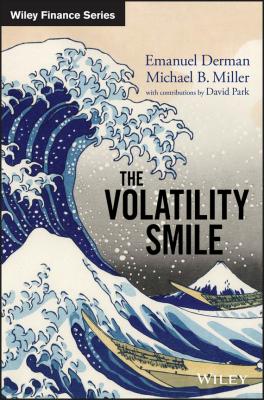ТОП просматриваемых книг сайта:
The Volatility Smile. Park Curry David
Читать онлайн.Название The Volatility Smile
Год выпуска 0
isbn 9781118959183
Автор произведения Park Curry David
Жанр Зарубежная образовательная литература
Издательство John Wiley & Sons Limited
More generally, assume that we dilute the risk of stock S by investing a percentage of our portfolio, w, in a risky stock and (1 – w) in riskless bonds. If w is 1, our portfolio is entirely invested in risky securities. If w is 0, our portfolio is entirely invested in riskless bonds. If 0 < w < 1 then our portfolio is a mix of risky and riskless securities. If w is greater than 1, then (1 – w) is negative and we are borrowing at the riskless rate in order to leverage our investment in the risky security.
Figure 2.5 shows the binomial tree of returns for a mixture of a risky security and riskless bonds. The expected return of this portfolio, μP, is simply the weighted average of the risky security and the riskless bonds:
(2.1)
Because the riskless bonds have no volatility, the volatility σP of the portfolio is simply wσ. By decreasing volatility from σ to wσ, we decrease the expected excess return to w(μ − r), the excess return being the return of a security or portfolio minus the riskless rate.
Figure 2.5 Binomial Tree for a Mixture of a Risky Stock S and a Riskless Bond
Define a new variable λ, the ratio of a security's excess return to its volatility, so that
(2.2)
The variable λ is the well-known Sharpe ratio. Now, for the portfolio of a risky security and riskless bonds in Equation 2.1, the Sharpe ratio is
(2.3)
The Sharpe ratio of the portfolio is equal to the Sharpe ratio of the risky security. Diluting a portfolio by investing part of the portfolio in riskless bonds has no effect on the Sharpe ratio.7
Now consider another uncorrelated stock S′ that has the same volatility wσ as the portfolio P. It has the same numerical risk as portfolio P consisting of S and a riskless bond, but, since it is a separate source of risk, uncorrelated with the behavior of S,both risks are unavoidable. The reformulated law of one price tells us that any security with unavoidable risk wσ must have expected excess return w(μ − r). Therefore, S′ must have the same return as P. Thus,
(2.4)
Equation 2.4 shows that the Sharpe ratio is the same both for the security S′ and for the security S. Therefore, in World #1, the Sharpe ratio must be the same for all stocks. By varying w in Figure 2.5, we can create portfolios P of any risk σP. Equation 2.3 shows that the excess return of any uncorrelated security will be proportional to its volatility. It confirms the popular maxim “More risk, more return,” which strictly speaking should read “More unavoidable risk, more expected return.”
Конец ознакомительного фрагмента.
Текст предоставлен ООО «ЛитРес».
Прочитайте эту книгу целиком, купив полную легальную версию на ЛитРес.
Безопасно оплатить книгу можно банковской картой Visa, MasterCard, Maestro, со счета мобильного телефона, с платежного терминала, в салоне МТС или Связной, через PayPal, WebMoney, Яндекс.Деньги, QIWI Кошелек, бонусными картами или другим удобным Вам способом.

